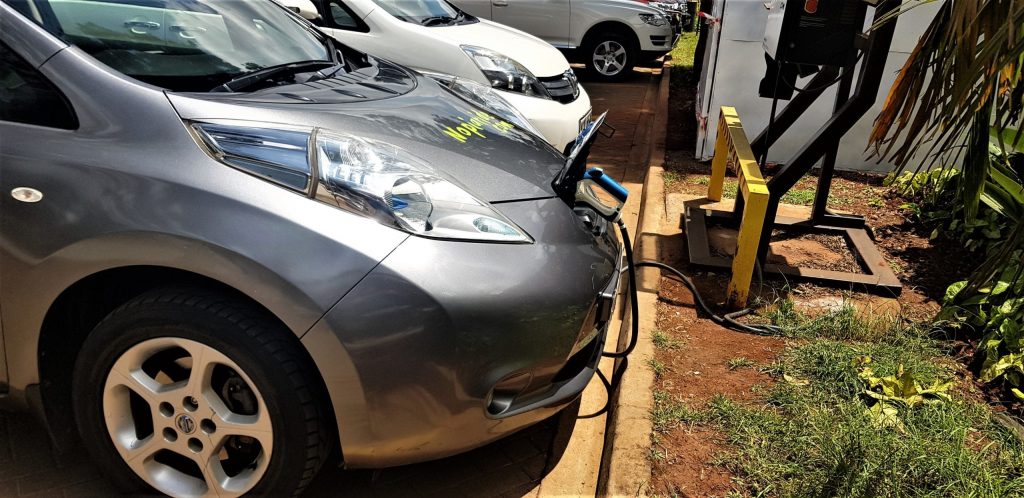Finnish firm EkoRent has finished piloting its Nopea Ride electric cabs in Nairobi and is now moving to grow its fleet on city roads to 40 by April with the transition to the commercial phase.
The CEO and founder Juha Suojanen said that 10 more electric cars are being shipped in, giving a lift to its current fleet of 30 taxis.
Additionally, the company looks to open new charging stations at two more locations in Kenya’s capital by April. This would take the number to five when added to its current three charging premises – Hub Karen, Thika Road Mall and Two Rivers Mall. All the charging sites are connected to the national grid and hybridised by captive solar power as part of Nopea’s strategy to promote the use of clean energy.
“We’re now in our scale-up phase and rapidly growing our fleet. We currently have 30 cars in Nairobi and we look to grow the number to 40 by the end of April. We’re also opening two more service stations before the end of April,” Suojanen told Africa Sustainability Matters.
Nopea Ride has been piloting the electric rides since late 2018 when it pioneered the concept in Kenya.

“Having completed our pilot runs in Nairobi, we certainly hope that Nopea can scale quickly and that its service achieves a critical mass in terms of adoption, in order to drive this new wave of transport service,” said Suojanen.
“The pricing model is favorable and fair. It’s also economically sustainable for the drivers. This is because once our car is purchased, the charging is entirely free to the user,” he added.
The International Finance Corporation (IFC) estimates that Nairobi’s electric cars market will hit $5 billion (Sh500 billion) over the next 10 years to 2030. This presents a golden opportunity for investors.
Aside from Nopea, Nairobi-based green energy company Opibus is in the business of electric conversion of off-road vehicles like Land Cruisers and Land Rover Defender, targeting campsites and wildlife conservancies having off-grid solar plants.
The company plans to start converting petrol and diesel public passenger vehicles (matatus) on Kenyan roads to electric vehicles.
The fossil fuel-to-electric conversion involves removal of engines from petrol vehicles and replaced with electric motor and battery pack. Also removed is the fuel tank, along with the gearbox, both of which are rendered obsolete by the electric drive.
Nairobi’s public transport is rickety. Besides the daily chaos and traffic, city commuters are forced to put up with the din of engine noise and plumes of exhaust fumes from millions of tailpipes, some of which lack catalytic converters. This carries the risk of exposing city residents to respiratory diseases, especially so because most matatus are notorious for engine idling, even when parked.
In addition to being pollution-free, Nopea Ride says its electric taxis offer low-cost travel to cab customers as a result of fuel expenses being cut off and bare-minimum repairs, pushing down fares.
“Nopea cars have fewer parts to funnel energy through, undergo less energy conversion hence less energy loss compared to gas-powered engines,” said Suojanen.
“As fuel prices in Kenya keep fluctuating, this disruptive technology could save taxi drivers the headache of such volatility. Drivers also stand to gain higher revenues compared to traditional gasoline cars since charging the Nopea cars is absolutely free.”
Electric vehicle experts say that operating an electric car offers simplicity and fewer hassles besides the lower cost benefits.
For instance, the electric motor has only one moving part in comparison to the combustion engine that consists of thousands. This means the risk of something breaking down is reduced significantly, according to experts. Owing to removal of gearbox, costly maintenance and breakdown risks are also avoided.
Equally, using an electric motor gives the advantage of having constant peak torque right at the tip of the pedal, starting from zero (0) RPM (revolutions per minute/ how fast the engine turns). This means the driver has full force of the motor at disposal already from stationary, whereas a traditional combustion engine delivers peak torque at around 2500 RPM. The total efficiency of the electrical motor is 94-96 percent, in comparison to around 20-30 percent for a combustion engine.
Read also: Oil Dealer TOTAL Spreads Footprint In Green Energy With Solar Kiosks




